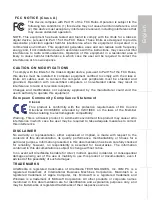
11
Operating precautions
Shoot under the proper lighting conditions.
To produce pictures with eye-pleasing colors, shoot under
the proper lighting conditions.
The pictures may not appear with their proper colors when
shooting under fluorescent lights.
Select the proper lighting as required.
To ensure a stable performance in the long term
Using the unit for prolonged periods in locations where the
temperature and humidity levels are high will cause its parts
to deteriorate, resulting in a reduction of its service life.
(Recommended temperature: Max. 35 °C {95 °F})
Ensure that a cooling unit or heating unit will not blow any
air directly toward the installation location.
Image persistence on the CMOS sensor color filters
If parts of the CMOS sensor are exposed continuously to
spotlights or other bright lights, the color filters inside the
CMOS sensor will deteriorate, and the parts concerned may
become discolored.
Do not point the camera at strong
lights.
When parts of the CMOS sensor are
exposed to spotlights or other strong
lights, blooming (a phenomenon where
the edges of strong lights become
blurred) may occur.
Bright subject
Blooming
Concerning the color reproduction of CMOS sensors
Depending on the color tones of the subjects, the color
reproduction may deteriorate: This is normal and not
indicative of any trouble.
What happens with high-brightness subjects
Flare may occur if an extremely bright light source is pointed
at the lens. In a case like this, change the angle or take
some other remedial action.
Operating temperature range
Avoid using the unit in cold locations where the temperature
drops below 0 °C {32 °F} or hot locations where the
temperature rises above 40 °C {104 °F} since these
temperatures downgrade the picture quality and adversely
affect the internal parts.
Concerning the HDMI interface standard
This unit has been certified as HDMI-compatible, but on rare
occasions images may not be displayed depending on the
HDMI device which has been connected to the unit.
Turn off the power before connecting or disconnecting
the cables.
Always be sure to turn off the power before connecting or
disconnecting the cables.












































